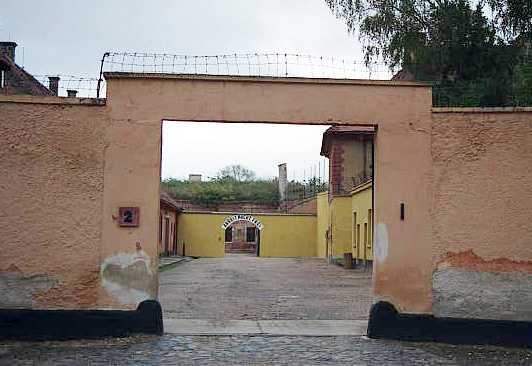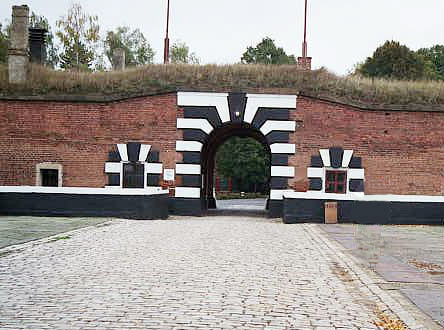Arbeit Macht
Frei Gate
 Sign over interior
gate in Small Fortress reads "Arbeit Macht Frei"
Sign over interior
gate in Small Fortress reads "Arbeit Macht Frei"
An interior gate in the Small Fortress
at Theresienstadt, shown in the background of the photograph
above, has black letters on a white band over the arch which
read "Arbeit Macht Frei." This cynical slogan was also
used at Dachau, Sachsenhausen, the main Auschwitz camp and a
few other Nazi concentration camps.
Two Jewish members of our tour group,
who were from Israel, were quite upset when they saw these cruel
words displayed inside the prison, but the guide explained that
there were actually some prisoners who were released from the
Small Fortress. According to a booklet that I purchased at the
Museum, there were 5,600 prisoners released from the Small Fortress,
which was a Gestapo prison for political prisoners and captured
partisans.
When Theresienstadt was built as a military
fortress in 1780, it consisted of two parts: the Main Fortress,
where the Jews were later imprisoned by the Nazis in World War
II, and the Small Fortress which was originally built as a prison
and was used as such from the time it was completed until a few
years after World War II, when the last of the German war criminals,
who were incarcerated here by the victorious Allies, were executed.
The Small Fortress is on the east side
of the Ohre river that divides the two parts of the old military
fortress, and the Theresienstadt ghetto is on the west side.
The Small Fortress was open to tourists from 8 a.m. to 4:30 p.m.
daily when I visited in October 2000. The Main Fortress is now
the town of Terezin, which is, of course, always open to visitors,
and even has a hotel where tourists can stay if you don't mind
spending the night in the exact location where Hitler's SS soldiers
once slept.
 Exterior Gate into
the Small Fortress
Exterior Gate into
the Small Fortress
If you've ever researched the subject
of Theresienstadt, you have probably seen a picture of the main
entrance into the Small Fortress, which is shown in the photograph
above. It looks very menacing with its distinctive black and
white border around the entrance arch; it is often shown in tourist
guidebooks or on Holocaust web pages.
The main gate, shown in the photo above,
was designated the Number 1 stop on the tour of the Small Fortress.
After entering this gate, our tour group walked a few yards into
the prison, then turned left to go through the Administration
Court which was Number 2 on the tour. You can see the number
on the square archway in the foreground in the photograph at
the top of this page. Throughout the tour, I had to lag behind
the group in order to take these photographs.
The Small Fortress became a Gestapo prison
in June 1940, even before the Main Fortress was turned into a
transit camp for the Jews in November 1941. The following quote
is from a pamphlet that I obtained on the tour:
People were sent here for taking part
in the democratic and communist resistance movement, for aiding
parachutists sent from the west and east to help the Czech resistance,
for supporting partisans, escaped prisoners-of-war and Jews,
or for individual acts against the Nazi regime. They were intellectuals,
workers, farmers, clericals, artists and students, men and women.
The fate of the Jewish prisoners here was particularly tragic.
After arrest by the Gestapo for taking part in the resistance
movement or breaking the rules established for Jews in Terezin
town, they were sent here, given the hardest work and subjected
to the worst terrorism by the guards. It was actually a transit
prison as most of the inmates were sent after a certain time
before a Nazi court and from there to other prisons and penitentiaries
or to concentration camps in Germany, Poland and Austria.
|